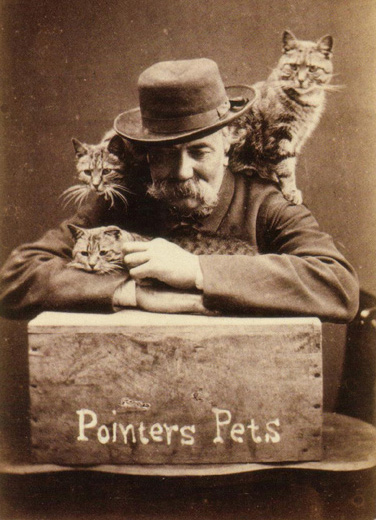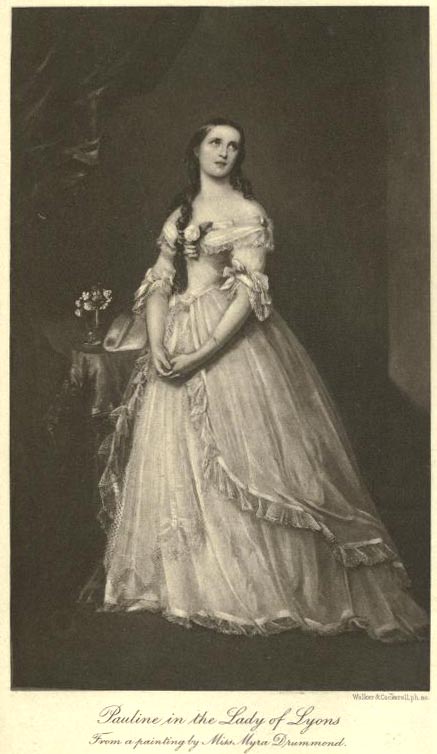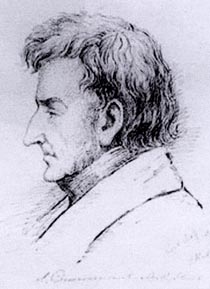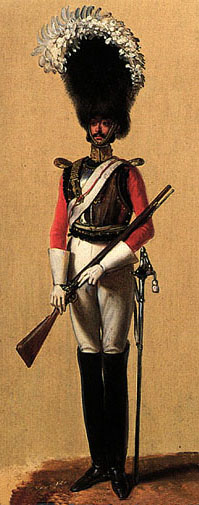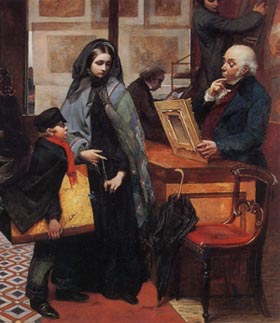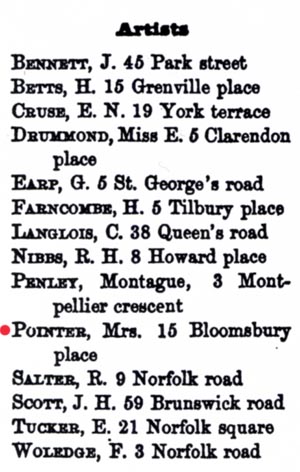Henry "Harry"
Pointer was born at Marcham,
As a young man, Harry Pointer enlisted in the 1st Regiment of the Life Guards. Coming from a family of poor agricultural workers, Harry Pointer probably saw the prospect of serving in an elite army regiment charged with the duty of protecting the Queen of England as a more attractive alternative to labouring in a farmer's field.
The Life Guards had served with distinction at the Battle of Waterloo, but after the defeat of Napoleon, the regiments of the Household Cavalry returned to their main role of protecting the monarch. For much of his military career, Harry Pointer would have been based in London at the Hyde Park barracks of the Household Cavalry. The Hyde Park Barracks in Knightsbridge were less than a mile from Buckingham Palace, the official London residence of Queen Victoria. Harry Pointer would not have seen any military action abroad, as the main duties of the the Life Guards Regiment was to protect the Queen at her London residence, providing a mounted military escort when necessary, and carrying out various ceremonial duties on State and Royal occasions.
As a member of an elite army regiment, we can assume that Harry Pointer was a fine figure of a man, especially when dressed in ceremonial gear. Harry Pointer would have been a relatively tall man as regulations specified that recruits to the Life Guards had to be at least five feet, ten inches in height. We also know from later photographic portraits that Harry Pointer had a luxuriant moustache, which probably dated from his time in the Life Guards. ( A nineteenth century account of the regiments of the Household Cavalry notes that " in 1821, for the first time, the men were directed to wear the moustache" ). The circumstances surrounding his introduction to his future wife, the artist Rosa Myra Drummond, indicates that it was Harry Pointer's physical stature, and in particular his good, strong legs, which recommended him to Miss Drummond.
In the 1840s, Rosa Myra Drummond (born 1816, St Anne's Soho, London*), was a promising young artist and portrait painter. Rosa (Rose) Myra Drummond was the daughter of Samuel Drummond (1766-1844), a portrait and history painter, and his third wife Ann Holanby (born c1786). Rosa Myra Drummond's brother Julian Drummond (born c1828, St Anne's Soho, London) was also an artist and portrait painter. Miss Drummond had achieved some recognition for her portrait of the famous actress Helena Saville Faucit (1817-1898), but by 1845 she was a struggling artist living in virtual poverty.
In her memoir "Landmarks of a Literary Life", the author Camilla Dufour Toulmin (1812-1895), the wife of Mr. Newton Crosland, a prosperous wine merchant, recalls meeting and becoming friends with Rosa Myra Drummond in the late 1840s and tells the "pathetic story" of the circumstances leading to the artist's marriage to Harry Pointer, then a young soldier in the Life Guards. According to Mrs Crosland, a painting featuring a Roman soldier had been "delayed from the difficulty in finding a suitable pair of legs from which to paint; but she added that her brother (Julian) had at last discovered a life-guardsman (Harry Pointer), who exactly answered the purpose of a model for her Roman soldier". Mrs Crosland continued : " ... I heard more of her handsome life-guardsman, who, I fancy, served for other subjects besides the Roman soldier. In hours off duty he also carried Myra Drummond's paintings to the picture dealer for sale....I remember she considered he had a real appreciation and love of art, and had been of the greatest service to her. And the next thing I heard was that they were married !".
Harry Pointer married Rosa Myra Drummond at St Andrew's Church, Clewer, near Windsor, on 11th August 1849. Harry Pointer, who was serving as a Corporal in the Life Guards Regiment, was twenty-six years of age at the time of their marriage. Harry's bride, Rosa Myra Drummond, who had been born in December 1816, would have been thirty-two, yet, perhaps conscious of the age difference, she was recorded on future census returns as a few years younger than her husband. On the marriage certificate, Rosa signed her name as "Rose Myra Drummond" and, although she does not state her profession on the certificate, she proudly declared that she was the daughter of Samuel Drummond, Artist and "Member of Royal Academy". Harry Pointer informed the registrar that his father, John Pointer, was employed as a Gentleman's "Servant".
After their marriage, the couple set up home in Albany Street, Regents Park, London. As a serving soldier in the Life Guards Regiment, Harry Pointer was stationed either at The Regents Park Barracks or the Hyde Park Barracks*, not too far away from the house in Albany Street, where his wife resided. [* Roger Viggers, a former member of The Life Guards, has since advised me that it was possible that Harry Pointer was based at The Regents Park Barracks in Albany Street with The First Life Guards ].
In the Summer of 1851, Mrs Pointer's friend, Mrs Newton Crosland journeyed from Blackheath to Albany Street to call upon the artist. In her memoir, "Landmarks of a Literary Life", Mrs Crosland recalled her visit to Mrs Myra Drummond Pointer and a conversation they had about the social class differences between Myra and her soldier husband :
|
This visit was about two or three months before the birth of her
first child (Harry Pointer
junior). Her
husband was still in the ranks ; and apartments in Albany Street
had been chosen on account of their proximity to the barracks. She
seemed glad to see me, and spoke very freely of the step she had
taken (i.e. marrying an
ordinary soldier), and, certainly,
without regret. Of course, I made the best of her position, and I
remember saying something to the effect that many a gentleman, in
a fit of temper or distress, or from incapacity in other ways to
enter the army, had enlisted as a private soldier. And she
retorted, "My husband was not a gentleman, he is one of fives
sons, peasant-born". And I am really sure she added, "they are all
in the army". The old pride was quite as rampant as ever. There
was also the old look also in her eyes, that look which poor L. E.
L. described as being "heavy with the weight of unshed tears"; and
yet this look was a little less marked than it had been in former
times. She seemed thoroughly aware that a woman could not raise
her husband's social position, though a duke might raise any
virtuous girl to his own. This was the last time I saw Myra
Drummond, now Mrs Pointer. The next thing I heard was that Mr Pointer had left the army, and in conjunction with his wife, had taken up photography and settled at Brighton." From "Landmarks of a Literary Life", by Mrs Newton Crosland (Camilla Dufour Toulmin) pages 204-205 |
Mrs Rosa Myra Drummond Pointer gave birth to a baby boy, during the 3rd Quarter of 1851. The child was named Harry Pointer junior after his father. [The birth was recorded in the Pancras Registration District, which covered the Regents Park area of London]. The Pointer family were still living in the area of Regents Park when a second child, Myra Pointer, was born during the 2nd Quarter of 1852.
For a brief period, Mrs Pointer supplemented her husband's soldier's pay by painting portraits. Mrs Newton Crosland noted that "one of the officers in her husband's regiment had known her father, and gave her some portrait-painting commissions". According to Mrs Crosland, from the beginning of their relationship, Harry Pointer, had "carried Myra Drummond's paintings to the picture dealer's for sale, with instructions, I am afraid, to take almost anything that was offered for them" (Crosland, page 204). In the 1850s, Mrs Pointer continued to try to sell her paintings. In 1856, The British Institution made reference to an artwork called "Roman Drovers" painted by R. M. Pointer of 38 Upper Albany Street, London, which shows that Mrs Pointer was still working as a professional artist in London in the mid-1850s.
By 1860, Henry Pointer had left the army and was residing with his wife and children in Brighton. The Pointer family set up home in College Road in the Kemp Town area of Brighton. Harry Pointer, being an ex-soldier, established himself as an Instructor in Military Drill at Lancaster House, College Road, Brighton, close to Brighton College, an independent public school on Brighton's Eastern Road. When the 1861 census was taken, Henry Pointer was described on the return as a "Drilling Master", aged 38. Mrs Rosa M. Pointer is entered on the census return as an "Artist", aged 35, ten years younger than the age suggested by her record of baptism. Residing with Henry Pointer and his wife were their two children, ten year old Harry and nine year old Myra. Within a few years, Harry Pointer and his family had moved to 15 Bloomsbury Place, Brighton.
|
|
| [ABOVE] A portrait of the Brighton photographer Harry Pointer with three of his cats, a carte-de-visite photographed at Harry Pointer's photographic studio in Bloomsbury Place, Brighton around 1880. The Photographic News commented on this picture in 1884 : "Mr Pointer presents us with his own portrait, as he once appeared with three of his pets." |
|
[PHOTO : Courtesy of Philippe Garner] |
|
|
| [ABOVE] A nineteenth century print showing a Corporal in the 1st Regiment of the Life Guards in full dress. Harry Pointer enlisted in the 1st Regiment of the Life Guards as a young man and was serving in the regiment when he first met his wife. The Life Guards, which is one of the regiments that make up the Household Cavalry, were not involved in any military action during the years that Harry Pointer served in their ranks. After the gallantry they displayed at the Battle of Waterloo, the Life Guards returned to their main role of protecting the monarch and so Harry Pointer would have spent most of his military career stationed in London. |
|
|
| [ABOVE] An advertisement which appeared in the Brighton Gazette on Thursday, 27th February 1862, advertising the services of Mr. Pointer, who offered private lessons in "Military Drill". Harry Pointer, who was now approaching forty, had spent many years as a trooper in the 1st Regiment of the Life Guards and teaching military drill seemed an obvious occupation for an ex-soldier. When Harry Pointer set himself up as a "Drilling Master", a new craze for carte-de-visite photographic portraits was sweeping the country, as the advertisement below demonstrates. By 1866, Harry Pointer and his wife, an accomplished portrait painter, had established a photographic portrait studio in Bloomsbury Place, near Brighton's seafront. |
|
|
| [ABOVE] The publicity for Harry Pointer's Private Photographic Studio at 11 Bloomsbury Place, Marine Parade, Brighton, as printed on the reverse of one of his "Brighton Cats" cartes-de-visite (c1875) |
